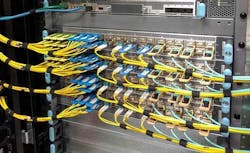Roundtable: Key Trends in Interconnection, Cloud On-Ramps
Today we continue our Data Center Executive Roundtable, a quarterly feature showcasing the insights of thought leaders on the state of the data center industry, and where it is headed. In today’s discussion, our panel of experienced data center executives – Intel Software’s Jeff Klaus, Erich Sanchack from Digital Realty, Cyxtera’s Mitch Fonseca, and Eric Boonstra of Iron Mountain – discuss key trends in interconnection services.
The conversation is moderated by Rich Miller, the founder and editor of Data Center Frontier.
Data Center Frontier: There’s currently huge interest in interconnection and network services. What are the most significant trends in the network features customers are seeking, and how providers are delivering these services?
ERICH SANCHACK, Digital Realty
Erich Sanchack: As every business becomes a digital business, point to point connection doesn’t cut it – businesses need near real-time interactions with a wide ecosystem of business partners and cloud providers, with greater security and reduced latency. Part of this trend is a growing realization that business innovation cannot happen solely within an organization and will likely need an evolving group of business partners and suppliers to establish future digital business models.
With this shift, we’re seeing a bigger trend away from dedicated connections to the outside world toward the use of flexible SDN connections from customer cabinets through to systems in the meet-me room. By using connections such as our Service Exchange, customers are able to make virtual connections to a wide range of clouds which can be established quickly through a software portal.
As organizations look at different cloud environments for different applications, software-defined ways to interconnect become key to optimizing the cloud traffic to reduce latency, simplify connectivity and provide real-time, reliable access to disparate data sources.
Connecting to multiple clouds across a traditional hub-and-spoke WAN infrastructure is costly and can be unreliable. Using architectures such as Service Exchange for interconnection makes the use of multiple clouds happen securely and with low latency – optimal for emerging applications like gaming or financial services.
The interest in interconnectivity is also driving a change in service-level agreements. Uptime alone, is no longer good enough. End-users want the increased speed from interconnectivity, because a slow network has effectively the same result as if the entire network is down.
Finally we’re seeing an interest from clients in interconnectivity driven by the proliferation of virtualization. This year analysts expect one out of every $10 spent on software to be devoted to virtualization. However, a network with a cloud interconnection foundation must be in place to ensure reliable access to bandwidth for virtualized applications.
MITCH FONSECA, VP, Data Center Products, Cyxtera
Mitch Fonseca: Unprecedented demand for edge computing and mission-critical, secure, direct access to cloud and SaaS platforms has made interconnection and network services the table stakes for most enterprises. According to 451 Research, one of the significant trends emerging to address this demand is a more cloud-like approach for how colocation and cloud interconnection is provisioned. 451 Research refers to this as “software-programmable interconnection…a form of network overlay – creating an easy way for customers to interconnect their presences in multiple data centers.”
Another key trend is the need for a variety of cloud connectivity options, not a one size fits all approach, to optimize total cost of ownership and improve resiliency. Enterprises want the freedom to choose their preferred path to the cloud or service provider they need. For example, many prefer to use cloud on-ramps rather than direct cloud connections. They prefer to save as much as 50 percent on their interconnection costs while only adding 1 to 1.3 milliseconds of latency roundtrip. Cloud on-ramps offer enterprises other advantages, including dual entrances into facilities and multiple network options to provide local, regional, and national availability zones.
Enterprises not only want access to more diverse and flexible network services from their data center providers; they want to easily manage these network services on-demand via API and self-service portal. Adaptable pay-as-you-go terms are also preferred over design-to-peak given the changing nature of enterprises’ bandwidth and connectivity needs.
ERIC BOONSTRA, Iron Mountain
Eric Boonstra: In the past, data centers were essentially individual storage blocks connected to users by a simple managed Ethernet or equivalent service. The connection to the customer was normally arranged by one of the service providers present in the DC.
Although this manner of working was manageable, it was also annoying – provisioning of circuits could take weeks and was mostly a manual, labor intensive operation prone to errors. Then cloud arrived. One of the consequences has been to concentrate data in larger facilities that may also be spread out geographically.
This presents cloud users with some questions: first, how do I access the data center; next, how do I access the cloud; and finally, can I scale up (or down)? These are some of the drivers that are causing data centers to look more closely at their ability to provide network services.
It’s not enough to be able to provide connectivity services. In this age of consumable services (everything as a service), customers are asking for the ability to turn on/turn off services whenever they want, to increase/decrease bandwidth whenever they want and to have elastic pricing – the ability to pay only for what is used, no more flat fees or having to contract for one year or longer.
They also want automation – the provisioning of services through a portal, whether their own or white labelled, even on a smart phone paid by credit card. This exists today and data centers must partner with these types of service providers in order to give customers what they expect. This is especially relevant for Iron Mountain as we have 95% of Fortune 1000 and approximately 250,000 enterprise relationships, many of whom are embarking on their digital transformation journey and will need scalable network services to connect to their cloud(s).
Jeff Klaus, General Manager of Intel Data Center Management Solutions
Jeff Klaus: Software defined networking, specifically SD-WAN and vCPE, are really coming into their own now. For example we’re getting use cases that demonstrate how application recognition software can utilize policy rules to dynamically route traffic through preferred tunnels back to corp or straight out to the internet depending on identified variables (including SLA). That functionality really enables global expansion by utilizing network capabilities effectively.
Of course 5G is the other side of that networking discussion, and will continue to be a hot topic because it will enable so many device interactions in the future and innovations.
NEXT: How can the supply chain keep pace with demand for hyperscale data center capacity?
Keep pace with the fact-moving world of data centers and cloud computing by following us on Twitter and Facebook, connecting with me on LinkedIn, and signing up for our weekly newspaper using the form below:
About the Author



